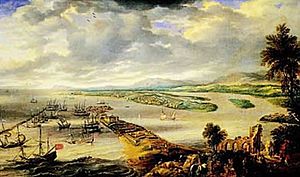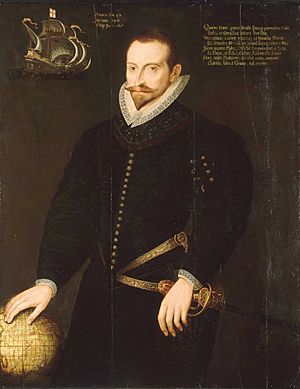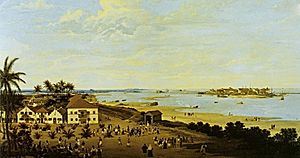Capture of Recife (1595) facts for kids
Quick facts for kids Capture of Recife (1595) |
|||||||
|---|---|---|---|---|---|---|---|
| Part of the Anglo–Spanish War | |||||||
 Recife in the early 17th century by Gillis Peeters |
|||||||
|
|||||||
| Belligerents | |||||||
| Commanders and leaders | |||||||
| Jorge de Albuquerque Coelho | James Lancaster | ||||||
| Strength | |||||||
| 350 soldiers and militia Unknown Indian allies |
5 ships 30 prizes 400 soldiers & sailors |
||||||
| Casualties and losses | |||||||
| 1 galley frigate captured, 29 other prizes Recife: 120 killed, wounded or captured 8 ships captured All stores captured |
60 casualties or to disease 1 prize scuttled |
||||||
The Capture of Recife was an important event during the war between England and Spain. In April 1595, an English fleet led by James Lancaster aimed to capture the city of Recife. Recife was a major port in Brazil, which was then controlled by Portugal and Spain together.
Lancaster's ships sailed across the Atlantic, taking many valuable items along the way. He successfully captured Recife and held it for almost a month. He also fought off several Portuguese attacks. The English took a lot of treasure, even hiring Dutch and French ships to help carry it all. This made the expedition a big success for England, both militarily and financially.
Why Recife?
During this time, England was at war with Spain. Portugal was also under the rule of the Spanish king. This meant that Portuguese ships and colonies were fair targets for English attacks.
James Lancaster was an experienced English sailor. He had traveled to the East Indies before. In 1593, he decided to lead an expedition to Portuguese Brazil. He wanted to get involved in the rich sugar and spice trade there. Lancaster gathered a small fleet of ships in late 1594. These ships were armed merchant vessels, meaning they were trading ships that could also fight. Lancaster himself knew a lot about Portugal and spoke Portuguese.
The Journey to Brazil
In October 1594, Lancaster's fleet left Plymouth, England. On their way, the English ships captured several Spanish and Portuguese vessels, which were called "prizes." Other English ships joined them, also bringing captured Spanish prizes. Together, they captured a large Spanish warship called a galley-frigate.
As they sailed south, some ships returned home with their captured goods. While getting supplies in Tenerife, Lancaster learned something exciting from prisoners. A rich ship from the East Indies had crashed near Olinda. Its valuable cargo was safely stored in Recife. This news made Lancaster even more determined to capture Recife. His fleet now had almost fifteen ships. They even turned the captured galley-frigate into a ship for carrying troops.
By the end of March 1595, Lancaster arrived at Recife. Recife is a major port where two rivers meet the Atlantic Ocean. It was governed by Jorge de Albuquerque Coelho. The city was protected by Fort São Jorge, located on a strip of land leading to Olinda.
When Lancaster arrived, he found three Dutch ships already there. They also wanted the valuable cargo. Lancaster met with the Dutch commander. They agreed to work together and share the spoils. The English had enough power to take and hold the town, which the Dutch did not.
Taking the City
On Good Friday, very early in the morning, Lancaster landed his troops on the beach. He surrounded Recife by both land and sea. This was to confuse the Portuguese about where the main attack would come from.
First, the English ships fired their cannons. Then, the English soldiers attacked from all sides. The Portuguese fought hard at first, but their resistance soon weakened. Fort São Jorge was quickly taken, and the strip of land was captured with only a few English losses. The city itself was taken with little fighting. The Portuguese soldiers fled to Olinda, about three miles away. Lancaster's forces had only ten casualties. He made sure there was no disorder or looting after the city was captured.
Now in control of Recife, Lancaster knew the Portuguese would try to fight back. He made Fort São Jorge stronger using the cannons they had captured. This fort connected Recife with Olinda. He then calmly loaded his ships with all the goods found in the town. There were nearly 100 houses and store buildings full of items. He even paid the Dutch captains to take some of the captured sugar and Brazil wood to England instead of Holland. He sent one of his own ships, Virgin, with them to make sure they did.
The Portuguese tried several times to retake the town. They attacked the fortified strip of land, but each time they were pushed back with heavy losses. They also tried to attack by water. They sent burning rafts down the river and fire-ships from the sea. But Lancaster's forces stopped these attempts too.
Some French privateers (sailors who attacked enemy ships for profit) arrived during the English occupation. Lancaster was a good diplomat. He gave them some Brazilwood to keep them happy. As a result, they left without any fighting. He even hired one of the French ships to sail to England. Some French sailors even stayed to fight with the English. With these extra fighters, Lancaster ordered an attack on Olinda. This was to stop the Portuguese from planning more attacks while the English secured their gains. They attacked Olinda at night, met little resistance, and took even more valuable goods, mostly sugar.
After staying in Recife for more than twenty days, Lancaster knew it was time to leave. He prepared his ships to sail. However, the Portuguese were building a new cannon battery to control the harbor entrance. Lancaster sent a strong group of 275 men to destroy it. They attacked at night and surprised the Portuguese, who ran away. The English destroyed the battery. But some English soldiers ran too far ahead, away from the protection of their ships' cannons. A large group of Portuguese soldiers and their Indian allies ambushed them. Almost all the English officers in that group, including Venner, were killed. About thirty-five men died before the rest reached the safety of the English lines.
Encouraged by this small victory, the Portuguese and their Indian allies launched another attack on the strip of land. But they were again pushed back, this time with the help of the English ships' cannons. After this close call, Lancaster decided the occupation was over. He left without further trouble, thanks to the destroyed battery.
What Happened Next?
Lancaster sailed away with fifteen ships full of goods. A strong storm scattered the fleet. Lancaster arrived in the Downs (an anchorage in England) in July with four ships. Only one ship, a captured Portuguese prize, never made it back. It was badly damaged in the storms and had too few crew members, so it was sunk.
The goods brought back were worth a huge amount of money. The cargo from the main ships was valued at £31,000. Other ships carried goods worth at least £15,000, bringing the total to over £51,000. Besides Brazil wood, the cargo included valuable spices like pepper, cloves, cinnamon, and mace. There were also indigo dye, Benzoin resin, frankincense, gum-lac, aloes, calicoes (cotton fabrics), silks, and valuable rutile quartz blonde stones.
An important capture was new Portuguese rutters (sailing directions or maps) found in Recife. Lancaster used these maps very effectively for the first ever English East India Company expedition in 1601.
When Philip II of Spain heard about the raid on Recife, he was very angry. He believed that any attack on his lands must be answered. Otherwise, his enemies would see it as a sign of weakness. As a result, the Spanish raided Mount's Bay in Cornwall, England, on August 13 of the same year as a way to get revenge.
The Portuguese later improved Recife's defenses. They built more forts on the land connecting Recife and Olinda to stop future attacks. However, the Dutch would return to Recife many times before being forced out in the mid-1600s by the Portuguese. The attack on Recife by James Lancaster was the last time the English attacked the coast of Brazil.
See also
- Siege of Recife (1630)
- Recapture of Recife
- East India Company



